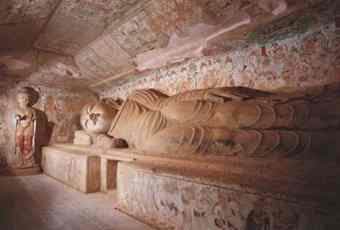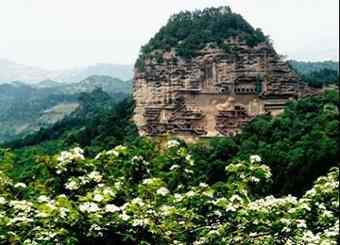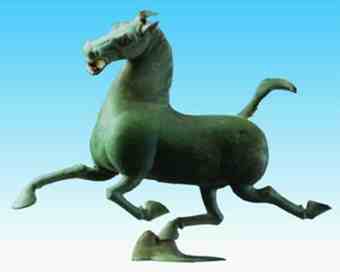Located on the eastern slope of Minsha Sand Dunes southeast of Dunhuang city, the Mogao Grottoes (also known as Thousand Buddha Cave) is one of three noted grottoes in China and also the largest, best preserved and richest treasure house of Buddhist art in the world.
 In 366 AD, during the Eastern Jin Dynasty, a monk named Yue Seng chiseled the first cave here. The endeavor continued through later dynasties, including the Northern Wei (386-534), Western Wei (535-556), Northern Zhou (557-581), Sui (581-618), Tang (618-907), Five Dynasties (907-960), Song (960-1279), Xixia (1038-1227) and Yuan (1279-1368), resulting in the fantastic group of caves that can been seen today.
In 366 AD, during the Eastern Jin Dynasty, a monk named Yue Seng chiseled the first cave here. The endeavor continued through later dynasties, including the Northern Wei (386-534), Western Wei (535-556), Northern Zhou (557-581), Sui (581-618), Tang (618-907), Five Dynasties (907-960), Song (960-1279), Xixia (1038-1227) and Yuan (1279-1368), resulting in the fantastic group of caves that can been seen today.
Today, 492 caves still stand, containing some 2,100 colored statues and 45,000 square meters of murals. These murals, if joined together, would cover a length of 30 kilometers. The caves vary in size. The smallest one just allows a head's space, while the largest one stretches from the foot to the top of the mountain, having a height of over 40 meters. The colored statues also differ in size, ranging from a few centimeters to 33 meters high, embodying the remarkable imagination of their makers.
 Despite years of erosion, the murals are still brightly colored, with clear lines. Through pictures of different styles and schools drawn in different historical periods, they tell Buddhist stories and ways as well as life in the secular world. All these, plus a largest quantity of Buddhist sutras and relics kept in the caves have provided valuable material for a study of ancient China's politics, economy, and culture and arts, as well as its science and technology, military affairs, and religion, documenting national history as well as cultural exchanges between China and the world. In 1987, UNESCO placed the Mogao Grottoes under the protection of the world cultural heritage list.
Despite years of erosion, the murals are still brightly colored, with clear lines. Through pictures of different styles and schools drawn in different historical periods, they tell Buddhist stories and ways as well as life in the secular world. All these, plus a largest quantity of Buddhist sutras and relics kept in the caves have provided valuable material for a study of ancient China's politics, economy, and culture and arts, as well as its science and technology, military affairs, and religion, documenting national history as well as cultural exchanges between China and the world. In 1987, UNESCO placed the Mogao Grottoes under the protection of the world cultural heritage list.
 Jiayuguan Pass Town, the western starting point of the Great Wall of Ming Dynasty, was initially built in 1372, is reputed as the "Impregnable Pass under Heaven" or "the Frontier Throat" for its strategic commanding position and grand structures. The Pass Town is composed of the internal wall, the external wall and the moat. With the exposed wall joined the No.1 beacon tower and the hidden one linked the Great Wall, the solid military defense system of the western Great Wall of Ming Dynasty came into being. On the Jiayuguan's rampart stand 14 turrets, towers and strobes. Inside the Pass Town there is a mansion for general, the Wenchang Palace.
Jiayuguan Pass Town, the western starting point of the Great Wall of Ming Dynasty, was initially built in 1372, is reputed as the "Impregnable Pass under Heaven" or "the Frontier Throat" for its strategic commanding position and grand structures. The Pass Town is composed of the internal wall, the external wall and the moat. With the exposed wall joined the No.1 beacon tower and the hidden one linked the Great Wall, the solid military defense system of the western Great Wall of Ming Dynasty came into being. On the Jiayuguan's rampart stand 14 turrets, towers and strobes. Inside the Pass Town there is a mansion for general, the Wenchang Palace.
 Mt.Maijishan is one of China's top scenic spots because of its peculiar grottoes, exquisite clay sculptures, luxuriant vegetation, various rock formations and landforms, and mountain peaks. Its main area is 142 square kilometers, including Maijishan Grottoes, the Immortal Cliff, the Stone Gate, Quxi Stream and Jieting Hot Spring. The Maijishan Grottoes are located southeast of Tianshui City in Gansu on a 142 meter-high hill named Maijishan, meaning "wheat-pile hill". Work on the grottoes started in the late 4th century and continued through the successive Northern Wei (386-534 AD) and Song (960-1279 AD) dynasties until the 19th century. There are 194 existing caves, in which are preserved more than 7,000 sculptures made of terracotta and over 1,000 square meters of murals. Earthquakes, rain and fire have damaged a large part of the caves and wooden structures.
Mt.Maijishan is one of China's top scenic spots because of its peculiar grottoes, exquisite clay sculptures, luxuriant vegetation, various rock formations and landforms, and mountain peaks. Its main area is 142 square kilometers, including Maijishan Grottoes, the Immortal Cliff, the Stone Gate, Quxi Stream and Jieting Hot Spring. The Maijishan Grottoes are located southeast of Tianshui City in Gansu on a 142 meter-high hill named Maijishan, meaning "wheat-pile hill". Work on the grottoes started in the late 4th century and continued through the successive Northern Wei (386-534 AD) and Song (960-1279 AD) dynasties until the 19th century. There are 194 existing caves, in which are preserved more than 7,000 sculptures made of terracotta and over 1,000 square meters of murals. Earthquakes, rain and fire have damaged a large part of the caves and wooden structures.
Leitai Han Tomb is located inside the Leitai Park in Wuwei city. It is a large tomb built with brick and stone in the late years (186-219) of the Eastern Han Dynasty, from which the Bronze Galloping Horse, the logo of China's tourism was unearthed. There are 231 cultural relics and 99 bronze chariots with honored guards of tomb figure unearthed from this tomb.
 The greenish Bronze Galloping Horse, also named as the "horse with hoof on a swallow", is 34.5 centimeters high, 45 centimeters long and weighs 7.15 kilograms. The wonder is that the galloping modeling of horse surpassed the flying swallow with three hoofs, head and tail raised in the air, completely complying with the equilibrium theory of mechanics, reflecting the rich cultural contents of the "Heaven Horse". It was cast with such excellent skill and can be reputed as the masterwork of the Bronze Art. Leitai Park has been turned into a hot scenic zone featuring the "Heaven Horse Culture" today.
The greenish Bronze Galloping Horse, also named as the "horse with hoof on a swallow", is 34.5 centimeters high, 45 centimeters long and weighs 7.15 kilograms. The wonder is that the galloping modeling of horse surpassed the flying swallow with three hoofs, head and tail raised in the air, completely complying with the equilibrium theory of mechanics, reflecting the rich cultural contents of the "Heaven Horse". It was cast with such excellent skill and can be reputed as the masterwork of the Bronze Art. Leitai Park has been turned into a hot scenic zone featuring the "Heaven Horse Culture" today.
Source: Global Times [August 11, 2010]